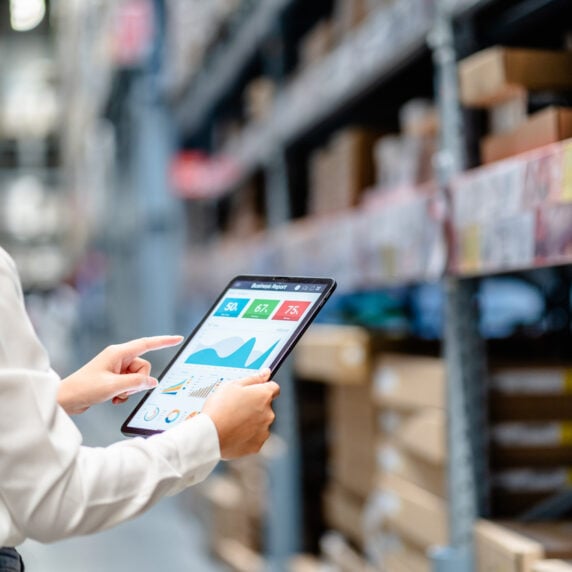The Five Key Takeaways from ShopTalk 2023
Sahil Gupta, Chief Product Officer at ToolsGroup, shares the most important insights and takeaways from this year’s ShopTalk conference.
After four days of retail insights focused on the trends, business models, and technologies that are shaping the future of retail, ShopTalk 2023 has closed a successful and illuminating conference. offering insights spanning shopper engagement, emerging channels, store experience, technology, and organization changes, the Las Vegas-based conference welcomed thousands of professionals from almost 3,000 established retailers and brands.
Our team was delighted to see the positive energy and enthusiasm permeating the whole event. The industry is definitely back in action after the sluggishness of Covid, and we’re looking forward to seeing retail gain momentum again.
There was a lot to take in. Whether you need a quick recap or didn’t get the chance to attend, here are the five major takeaways, distilled to help you apply the latest insights without missing a beat.
1. Redefining Omnichannel
The concept of omnichannel has been touted for a while, but from our conversations with industry leaders and peers, it has regained prominence in conversations throughout the retail industry.
This stems from the expansion of the definition of omnichannel. Once encompassing the interplay between brick-and-mortar stores and ecommerce avenues, omnichannel strategies are now beginning to stretch further and further into other selling channels.
For instance, marketplaces are quickly becoming new channels for traditional omnichannel networks. Many of the attendees we spoke to reported that they and their counterparts across the industry are exploring the ability to sell through a marketplace with a focus on Shopify emerging as a top partner.
Another gamechanger is social media. Driven by influencers on platforms like TikTok, live shopping is becoming widely popular. Powered by Shopify, TikTok provides retailers the ability to connect with customers, enabling consumers to make purchases any place, any time, even when they are not typically or actively “shopping.”
ToolsGroup Sales Executive Mallory Duffy with our partner Sonia Hernandez of Columbus Consulting
2. The Resurgence of AI
The second theme that caught our attention was renewed interest in artificial intelligence.
This may stem from the recent explosion of generative AI with hot-off-the-press coverage of innovations like ChatGPT, but more and more retailers are exploring AI-driven decision making across the commerce technology stack – from customer marketing to payments to operations.
Eye on the Horizon: Generative AI
At the moment, it seems that generative AI has not yet made its way into the retail technology vernacular. It may be too early to tell, but it’s likely this won’t be the case for long.
By next year, barring catastrophe or as yet unknown dangers, we predict that retail – like many industries – will be leveraging generative AI.
3. Composable Commerce
Many of the retailers we spoke to were also exploring the application of composable commerce.
Composable commerce is the concept of using headless services to build your own commercial stack (as opposed to using monolithic solutions for end-to-end capabilities).
This is most prevalent across the customer journey, where the traditional ecommerce platforms are being replaced with composable, developer-friendly solutions.
That being said, this is also making its way into the back end, primarily around the OMS.
4. Shifting the Focus from Customer Acquisition to Customer Experience and Retention
In our conversations with fellow attendees, we noticed a shift in focus. Though customer acquisition once dominated retail strategies, now attention is far more focused on heightening the customer experience and improving retention.
In the wake of Covid, as companies struggled amid disruptions and shortages, brand loyalty became less important to consumers than finding the item they needed. They began shopping anywhere their desired items were in stock.
This left retailers facing fluctuating demand from a more transient consumer base.
Now retailers are revitalizing their strategies to ensure they are a customer’s first point of purchase and have the structures in place to turn visitors into repeat customers.
And they are beginning to employ some new tactics to ensure that’s the case.
Leveraging Marketing and Social Strategy for Improved Forecasts
As direct-to-customer, ecommerce, marketplace, and social media selling channels begin to dominate channel diversification strategies, it is critical that forecast, inventory, pricing, and promotion strategies account for marketing strategies and budgets by channel.
In the past, planners have taken into account promotion campaigns, adding an appropriate inventory buffer to account for the expected lift in sales.
But now, in a world of fast-moving sales, driven by mounting click-through rates, marketing campaigns and budgets have an immediate and powerful impact on forecasts and inventory positions. These campaigns often shift channels so quickly that planners cannot rely on historical data.
Retailers that are embracing this new expanding omnichannel network must have tight integration between marketing and the planning team so planners know which channels are going to be impacted by marketing budgets and when.
This way, they can prepare inventory to fulfill demand most effectively for that channel before they are hit with spikes in demand. Better forecasts based on consumer trends allow retailers to drive more repeat purchases and higher lifetime value.
Flexible Payment
One way to draw customers in is to offer flexible payment options.
Traditionally, retailers managed this with store-specific, interest-charging cards.
After our discussions with attendees, it seems the industry is moving away from this model and towards partners and financial institutions that can offer competitive flexible payment structures.
Now, many retailers are partnering with financial institutions to offer flexible payment options to customers (e.g., monthly payments or buy now/pay later options).
Final Takeaway: How Can Retailers Stay Ahead of the Trends?
Customer behavior is evolving. Retailers need to not only focus on acquisition, but also retention. Between more flexible solutions, AI, and composability, a new brand of capabilities is emerging to help retailers.
So what’s the missing piece?
Accessing data in real-time still presents a problem, and a data platform can help. Retailers need a solution that leverages real-time perpetual inventory signals to dramatically improve agility, precision, and performance.
With a dynamic data unification platform, retailers can see near-live inventory data from across selling channels and serve that data to planning systems across its organization.
This powers dynamic planning capabilities for fulfillment, allocation, and replenishment, helping retailers stay agile and reduce network strain, while optimally positioning inventory for maximum customer satisfaction and profitability.







